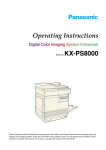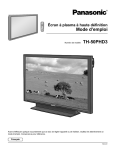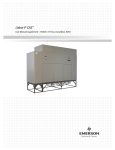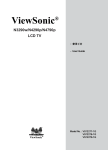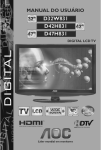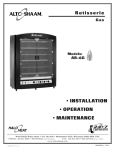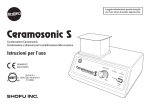Download 1 - Panasonic New Zealand Support Site
Transcript
INPUT TC-42PD1FA Wide Plasma Display Operating Instructions TQBC0211 Dear Panasonic Customer Welcome to the Panasonic family of customers. We hope that you will have many years of enjoyment from your new Wide Plasma Display. To obtain maximum benefit from your set, please read these Instructions before making any adjustments, and retain them for future reference. Retain your purchase receipt also, and note down the Model Number and Serial Number of your set in the space provided on the rear cover of these Instructions. Table of Contents IMPORTANT SAFETY NOTICE ................................3 Menu Flowchart ..................................................... 17 Safety Precautions...................................................4 ASPECT Controls .................................................. 18 Accessories ..............................................................6 PICTURE POS./SIZE Controls .............................. 20 Accessories Supplied.................................................6 SURROUND Controls............................................ 22 Optional Accessories .................................................6 PICTURE MODE Controls ..................................... 23 Remote Control Batteries........................................7 Picture Menu.......................................................... 24 Quick Start Guide.....................................................7 Sound Menu........................................................... 26 Set-up.........................................................................7 Signal Menu ........................................................... 27 Connections ...............................................................8 Set up Menu ........................................................... 28 Plug in and switch on .................................................9 SERIAL terminal .................................................... 29 Select the input signal ................................................9 Troubleshooting .................................................... 30 Basic Controls........................................................10 Specifications........................................................ 31 Connections ...........................................................11 Note: (1) If still pictures from sources such as video games or computers are projected for long periods, the image may become burned into the Wide Plasma Display panel (producing an “afterimage”). 2 IMPORTANT SAFETY NOTICE WARNING: To prevent damage which may result in fire or shock hazard, do not expose this appliance to rain or moisture. WARNING: 1) To prevent electric shock, do not remove cover. No user serviceable parts inside. Refer servicing to qualified service personnel. 2) Do not remove the earthing pin on the power plug. This apparatus is equipped with a three pin earthing-type power plug. This plug will only fit an earthing-type power outlet. This is a safety feature. If you are unable to insert the plug into the outlet, contact an electrician. Do not defeat the purpose of the earthing plug. WARNING This is a class A product. In a domestic environment this product may cause radio interference in which case the user may be required to take adequate measures. CAUTION To assure continued compliance, the shielded video cable with bonded ferrite sleeves must be used when connecting this Wide Plasma Display to video and computer equipment. (Refer to page 8, 12, 14 and 15) CAUTION This appliance is intended for use in environments which are relatively free of electromagnetic fields. Using this appliance near sources of strong electromagnetic fields or where electrical noise may overlap with the input signals could cause the picture and sound to wobble or cause interference such as noise to appear. To avoid the possibility of harm to this appliance, keep it away from sources of strong electromagnetic fields. 3 Safety Precautions WARNING Set-up This Wide Plasma Display is for use only with the following optional accessories. Use with any other type of optional accessories may cause instability which could result in the possibility of injury. BManufactured by Panasonic Pedestal TY-ST42PT1E BManufactured by Panasonic Wall stand TY-ST42PW1E BManufactured by Panasonic Mobile stand TY-ST42PF1E BManufactured by Panasonic Wall-hanging bracket (vertical) TY-WK42PV1E BManufactured by Panasonic Wall-hanging bracket (angled) TY-WK42PR1E BManufactured by Panasonic Ceiling unit TY-CE42PS1E Always be sure to ask a qualified technician to carry out set-up. Do not place the Wide Plasma Display on sloped or unstable surfaces. BThe Wide Plasma Display may fall off or tip over. Do not place any objects on top of the Wide Plasma Display. BIf water spills onto the Wide Plasma Display or foreign objects get inside it, a short-circuit may occur which could result in fire or electric shock. If any foreign objects get inside the Wide Plasma Display, please consult your local Panasonic dealer. If using the pedestal (optional accessory), leave a space of 10 cm or more at the top, left and right, 6 cm or more at the bottom, and 7 cm or more at the rear. If using some other set-up method, leave a space of 10 cm or more at the top, bottom, left and right, and 1.9 cm or more at the rear. When using the Wide Plasma Display The Wide Plasma Display is designed to operate on 220-240 V AC, 50/60 Hz. Do not cover the ventilation holes. BDoing so may cause the Wide Plasma Display to overheat, which can cause fire or damage to the Wide Plasma Display. Do not stick any foreign objects into the Wide Plasma Display. BDo not insert any metal or flammable objects into the ventilation holes or drop them onto the Wide Plasma Display, as doing so can cause fire or electric shock. Do not remove the cover or modify it in any way. BHigh voltages which can cause severe electric shocks are present inside the Wide Plasma Display. For any inspection, adjustment and repair work, please contact your local Panasonic dealer. Securely insert the power cord plug as far as it will go. BIf the plug is not fully inserted, heat may be generated which could cause fire. If the plug is damaged or the wall socket plate is loose, they should not be used. Do not handle the power cord plug with wet hands. BDoing so may cause electric shocks. Do not do anything that might damage the power cable. When disconnecting the power cable, hold the plug, not the cable. BDo not damage the cable, make any modifications to it, place heavy objects on top of it, heat it, place it near any hot objects, twist it, bend it excessively or pull it. To do so may cause fire and electric shock. If the power cable is damaged, have it repaired at your local Panasonic dealer. If not using the Wide Plasma Display for a prolonged period of time, pull the power cord plug out from the wall outlet. 4 Safety Precautions If problems occur during use If a problem occurs (such as no picture or no sound), or if smoke or an abnormal odour starts to come out from the Wide Plasma Display, immediately pull the power cord plug out from the wall outlet. BIf you continue to use the Wide Plasma Display in this condition, fire or electric shock could result. After checking that the smoke has stopped, contact your local Panasonic dealer so that the necessary repairs can be made. Repairing the Wide Plasma Display yourself is extremely dangerous, and should never be done. If water or foreign objects get inside the Wide Plasma Display, if the Wide Plasma Display is dropped, or if the cabinet becomes damaged, disconnect the power cord plug immediately. BA short may occur, which could cause fire. Contact your local Panasonic dealer for any repairs that need to be made. CAUTION When using the Wide Plasma Display Do not bring your hands, face or objects close to the ventilation holes of the Wide Plasma Display. BHeated air comes out from ventilation holes and the top of Wide Plasma Display will be hot. Do not bring your hands or face, or objects which cannot withstand heat, close to this port, otherwise burns or deformation could result. Be sure to disconnect all cables before moving the Wide Plasma Display. BIf the Wide Plasma Display is moved while some of the cables are still connected, the cables may become damaged, and fire or electrical shock could result. Cleaning and maintenance The front of the display panel has been specially treated. Wipe the panel surface gently using only the accessory cleaning cloth or a soft, lint-free cloth. BIf the surface is particularly dirty, wipe with a soft, lint-free cloth which has been soaked in pure water or water to which a small amount of neutral detergent has been added, and then wipe it evenly with a dry cloth of the same type until the surface is dry. BDo not scratch or hit the surface of the panel with fingernails or other hard objects, otherwise the surface may become damaged. Furthermore, avoid contact with volatile substances such as insect sprays, solvents and thinners, otherwise the quality of the surface may be adversely affected. If the cabinet becomes dirty, wipe it with a soft, dry cloth. BIf the cabinet is particularly dirty, soak the cloth in water to which a small amount of neutral detergent has been added and then wring the cloth dry. Use this cloth to wipe the cabinet, and then wipe it dry with a dry cloth. BDo not allow any detergent to come into direct contact with the surface of the Wide Plasma Display. If water droplets get inside the unit, operating problems may result. BAvoid contact with volatile substances such as insect sprays, solvents and thinners, otherwise the quality of the cabinet surface may be adversely affected or the coating may peel off. Furthermore, do not leave it for long periods in contact with articles made from rubber or PVC. Disconnect the power plug from the wall outlet as a safety precaution before carrying out any cleaning. BElectric shocks can result if this is not done. Clean the power cable regularly to prevent it becoming dusty. BIf dust builds up on the power cord plug, the resultant humidity can damage the insulation, which could result in fire. Pull the power cord out from the wall outlet and wipe it with a dry cloth. 5 Accessories Accessories Supplied Check that you have the accessories and items shown Operating Instruction book Remote Control Transmitter TNQE178 Batteries for the Remote Control Transmitter (2 × R6 (UM3) Size) PLASMA DISPLAY INPUT PC MANUAL-ASPECT-AUTO PICTURE MODE MENU N STR PICTURE POS./SIZE RCA-BNC adaptor plug TJS1A4270 Cleaning Cloth TPEX006 Ferrite sleeve TSK1027 Guarantee Card Optional Accessories BPedestal TY-ST42PT1E BWall stand TY-ST42PW1E BMobile stand TY-ST42PF1E BWall-hanging bracket (angled) TY-WK42PR1E BCeiling unit TY-CE42PS1E BRS-232C Conversion cable TY-SCP02RS1E 6 BWall-hanging bracket (vertical) TY-WK42PV1E Remote Control Batteries 1 2 3 R6(UM3) size Press and slide off the battery cover Insert batteries – note correct polarity (+ and –) Replace the cover Note: (1) Make sure that the batteries are fitted the correct way round. (2) Do not mix old batteries with new batteries. Remove old, exhausted batteries immediately. (3) Do not mix different battery types, i.e. Alkaline and Manganese. Do not use rechargeable (Ni-Cad) batteries. Quick Start Guide Set-up Be sure to use the special installation brackets (refer to page 6) when setting up the Wide Plasma Display. Always be sure to ask a qualified technician to carry out set-up. (Example) When using the pedestal to set up the Wide Plasma Display 1 2 Assemble the pedestal by attaching the poles. Insert the poles of the pedestal into the holes in the bottom of the Wide Plasma Display. 3 Secure the Wide Plasma Display at the back using the four screws. Note: (1) Refer to the Installation Instructions supplied with the pedestal for details on assembling the pedestal. 7 Quick Start Guide Connections Connecting the speakers. Refer to the Installation Manual for the speakers for details on speaker installation. Fit the speakers and connect the speakers. Rear R L SPEAKERS(8 ) INPUT (2) speakers (1) Connecting equipment such as a VCR. Connecting other types of equipment see pages 12 to 16. (Example) When connecting an S-VIDEO VCR. Rear (S-VIDEO VCR) R Audio OUT L Video OUT S-Video OUT L less than 20 cm Ferrite sleeve (Supplied) AUDIO AUDIO VIDEO S-VIDEO IN R AV Video input to S-VIDEO socket VIDEO 2 RCA Audio cables 8 OUT AUTO 75 /HI-Z Audio input to L/R sockets Quick Start Guide Plug in and switch on INPUT Power Switch Power Indicator ( ) The Power Indicator will light. Power-OFF.......... Indicator not illuminated Stand-by ......... Red Power-ON ........... Green Select the input signal 1 INPUT Press the INPUT button to select the input video signal to be played back from equipment such as a VCR which has been connected to the Wide Plasma Display. INPUT INPUT 1 9 Basic Controls INPUT Main Power On/Off Switch Power Indicator INPUT button (AV(S-Video)/Component, RGB/PC Mode Selection) Push the “INPUT” Button to select AV(S-Video) /Component, RGB/PC input signal modes sequentially. Status Button Push the “Status” Button to display the current system status. Stand-by (ON/OFF) button The Wide Plasma Display must first be switched on at the wall outlet and at the Power Switch. (See page 9) Push this button to turn the Wide Plasma Display ON, from STANDBY mode. Push it again to turn the Wide Plasma Display OFF, STANDBY mode. AV 4:3 Off timer 30 AV(S-Video)/Component, RGB/PC Mode Aspect Mode (See page 18) Off timer The off timer indicator is displayed only when the off timer has been set. Off Timer Button The Wide Plasma Display may be preset to switch to stand-by after a fixed period. The setting changes to 30 minutes, 60 minutes, 90 minutes and 0 minutes (off timer cancelled) each time the button is pressed. 30 60 90 0 When three minutes remain, “Off timer 3” will flash. The off timer is cancelled if the mains supply fails. PC Mode Selection Push the “PC” mode selection button to select the PC mode. This button is used to switch directly to PC mode. ASPECT-MANUAL button (see page 18) PICTURE MODE button (see page 23) MENU button 10 Volume Adjustment Push the Volume Up “+” or Down “–” Button to increase or decrease the volume level. PLASMA DISPLAY INPUT INPUT button (AV(S-Video)/Component, RGB/PC Mode Selection) Push the “INPUT” Button to select AV(S-Video)/Component, RGB/PC input signal modes sequentially. Sound mute On/Off PC MANUAL-ASPECT-AUTO ASPECT-AUTO button (see page 18) PICTURE MODE MENU Volume Adjustment Push the Volume Up “+” or Down “–” Button to increase or decrease the sound volume level. N Surround button (see page 22) N button (see page 21,24,25,26) STR STORE button PICTURE POS./SIZE Cursor buttons to make selections and adjustments PICTURE POS./SIZE button (see page 20) Connections Cable fixing bands Secure any excess cables with bands as required. To loosen To tighten Pull While pushing the knob Pull AV OUT Terminal (see page 15) TUNER IN Terminal (see page 16) L R L OUT AUTO 75 /HI-Z L Y/G TUNER IN REMOTE PC IN SERIAL AUDIO S-VIDEO R SPEAKERS Terminals (see page 8) PB/B AUDIO VIDEO IN SPEAKERS(8 ) PR/R REMOTE Terminal (see page 16) AV VD HD R COMPONENT/RGB IN AV IN Terminals (see page 12) PC IN Terminals (see page 14) SERIAL Terminal (see page 15) COMPONENT/RGB IN Terminals (see page 13) 11 Connections How to connect the AV Input Terminals S-VIDEO Signal Connection The Wide Plasma Display rear terminals (S-VIDEO VCR) L OUT AUTO 75 /HI-Z AUDIO VIDEO S-VIDEO IN R Audio OUT L Video OUT R S-Video OUT AV less than 20 cm Video input to S-VIDEO socket S-Video terminal pins layout Ferrite sleeve (Supplied) AUDIO Luminance earth Chrominance earth VIDEO Luminance in Chrominance in 2×RCA Audio cables Audio input to L/R sockets Video Signal Connection The Wide Plasma Display rear terminals (VCR) L OUT AUTO 75 /HI-Z R Audio OUT L Video OUT less than 20 cm Ferrite sleeve (Supplied) Installing the ferrite sleeve AUDIO VIDEO 1 S-VIDEO IN R AV Video input to BNC socket Pull back the tabs (in two places) VIDEO BNC Video cable AUDIO 2 2×RCA Audio cables Audio input to L/R sockets (VCR) R Audio OUT L less than 20 cm Video OUT Ferrite sleeve (Supplied) Video input to BNC socket 3 RCA-BNC adaptor plug (Supplied) VIDEO RCA Video cable AUDIO Pass the cable through and close 2×RCA Audio cables Audio input to L/R sockets Note: (1) Additional equipment and cables shown are not supplied with this set. 12 Open Connections How to connect the COMPONENT/RGB Input Terminals Component signals (Y, PB, PR) Connection DVD Player The Wide Plasma Display rear terminals PR/R PB/B L Y/G AUDIO R Audio OUT L DVD (Y,PB,PR,) OUT PB Y PR VD HD R COMPONENT/RGB IN Video input to Y,PB,PR sockets Y,PB,PR 3 RCA Video cables AUDIO 2 RCA Audio cables Audio input to L/R sockets Note: (1) Change the “COMPONENT/RGB IN” setting in the “Set up” menu to “Y/PB/PR”. (Refer to page 28.) (2) Additional equipment and cables shown are not supplied with this set. RGB signals (R, G, B, HD, VD) Connection Example of input signal source RGB input to R,G,B,HD,VD sockets G HDTV-compatible VCR B R The Wide Plasma Display rear terminals 5×RCA RGB cables PR/R PB/B L Y/G AUDIO or VD RGB camera HD R COMPONENT/RGB IN VD HD AUDIO 2×RCA Audio cables Audio input to L/R sockets Note: (1) Change the “COMPONENT/RGB IN” setting in the “Set up” menu to “RGB”. (Refer to page 28.) (2) Additional equipment and cables shown are not supplied with this set. 13 Connections How to connect the PC Input Terminals COMPUTER The Wide Plasma Display rear terminals TUNER IN REMOTE PC IN SERIAL Conversion adaptor (if necessary) D-sub 15p RGB RGB cable less than 20 cm less than 20 cm AUDIO Connect a cable which matches the audio output terminal on the computer. 3mm Stereo Plug Note: (1) Computer signals which can be input are those with a horizontal scanning frequency of 15.6 to 50 kHz and a vertical scanning frequency of 50 to 75 Hz. (However, signals cannot be displayed if they have a horizontal scanning frequency of less than 30 kHz and a vertical scanning frequency of more than 65 Hz, or a horizontal scanning frequency of more than 40 kHz and a vertical scanning frequency of less than 55 Hz.) (2) The display resolution is a maximum 640 × 480 dots when the aspect mode is set to “4:3”, and 852 × 480 dots when the aspect mode is set to “16:9”. If the display resolution exceeds these maximums, it may not be possible to show fine detail with sufficient clarity. (3) The PC input terminals are DDC1/2B-compatible. If the computer being connected is not DDC1/2B-compatible, you will need to make setting changes to the computer at the time of connection. (4) Some PC models cannot be connected to the set. (5) An adapter is required to use the RGB cable (D-sub 15P) to connect a PC-98 series computer (which has a D-sub 15P terminal) or a Macintosh computer to the set. (6) There is no need to use an adapter for computers with DOS/V compatible D-sub 15P terminal. (7) The computer shown in the illustration is for example purposes only. (8) Additional equipment and cables shown are not supplied with this set. (9) The picture will become dark if a PC signal with a vertical scanning frequency of over 62 Hz is input. To obtain the optimum picture quality with the Wide Plasma Display, a vertical scanning frequency of 60 Hz is recommended. (10) Do not set the horizontal and vertical scanning frequencies for PC signals which are above or below the specified frequency range. Signal Pin-out for D-sub 15P Connector 11 12 13 14 15 6 7 1 8 2 9 3 10 4 5 Pin Layout for PC Input Terminal 14 Pin No. Signal Name Pin No. Signal Name Pin No. Signal Name # R ) GND (Ground) / GND (Ground) $ G * GND (Ground) 0 SDA % B + GND (Ground) 1 HD/SYNC & GND (Ground) - NC (not connected) 2 VD ( GND (Ground) . GND (Ground) 3 SCL Connections How to connect the AV Output Terminal to other equipment The video output terminal outputs the signals which are input to the video input terminal. Monitor less than 20 cm Video output to BNC socket Video Output Terminal Ferrite sleeve (Supplied) VIDEO IN L OUT AUTO 75 /HI-Z AUDIO VIDEO S-VIDEO IN The Wide Plasma Display rear terminals R AV BNC Video cable Video Input Terminal Note: (1) The signal from the video output terminal is identical to the signal fed to the video input terminal. (2) Additional equipment and cables shown are not supplied with this set. How to connect the SERIAL Terminal The SERIAL terminal is used when the Wide Plasma Display is controlled by a computer. COMPUTER The Wide Plasma Display rear terminals TUNER IN REMOTE PC IN SERIAL RS-232C conversion cable(optional accessory) D-SUB 9pin Note: (1) Use the TY-SCP02RS1E RS-232C conversion cable (optional accessory) to connect the computer to the Wide Plasma Display. (2) Refer to page 29 for details of the control method for the Wide Plasma Display. (3) The computer shown is for example purposes only. (4) Additional equipment and cables shown are not supplied with this set. 15 Connections How to connect the REMOTE Terminal The REMOTE terminal is reserved for use with future compatible components. TUNER IN REMOTE PC IN SERIAL The Wide Plasma Display rear terminals How to connect the TUNER Input Terminal The TUNER Input terminal is reserved for use with future external compatible components. TUNER IN REMOTE PC IN SERIAL The Wide Plasma Display rear terminals 16 Menu Flowchart If the MENU button is pressed, the Menu screen will be displayed. If the MENU button is pressed once more while the menu screen is displayed, the Menu screen will be cleared. Menu On-Screen Indication Access STR Select Picture 0 Sound Tint 0 Brightness 0 Contrast 30 Sharpness 0 0 Warm White balance (Refer to page 24.) Colour Dynamic Picture Mode Colour Signal adjust Adjust Select Normal Picture Set up Off Manual W/B On MENU Exit Access STR Select Sound Picture Sound Change Select Normal Normal Sound Mode Picture Bass 0 Sound Treble 0 Signal Balance 0 BBE sound 16 MENU Exit Set up (Refer to page 26.) Access STR Signal Change Select Select Colour system Picture Auto Sound Change Colour matrix 1 2 MENU Exit Scan mode Field Signal Signal During Component mode MENU Exit Set up During AV(S-Video) mode Signal Signal Change Sync on G Off (Refer to page 27.) 31 V-Freq. (Hz) 60 MENU Exit During RGB and PC modes Access STR Set up Change Select Select Picture Sound Set up On H-Freq.(kHz) COMPONENT/RGB IN Y/PB/PR RGB Signal Panasonic Auto (4:3) 4:3 Just Set up OSD Language English (Refer to page 28.) MENU Exit 17 ASPECT Controls The Wide Plasma Display will allow you to enjoy viewing the picture at its maximum size, including wide screen “cinema format” picture. 1 ASPECT- AUTO ASPECT-AUTO Button (Panasonic Auto) Press the ASPECT-AUTO button to switch to Panasonic Auto mode. The display will automatically become enlarged. Panasonic Auto For an elongated image PLASMA DISPLAY INPUT Image is expanded Changes in accordance with the Panasonic Auto mode setting. (Refer to page 28.) For a 4:3 image PC 2 MANUAL-ASPECT-AUTO 1 PICTURE MODE MENU N STR Note: (1) If an S1 signal is detected while Panasonic Auto mode is active, the aspect mode will change to “16:9”. (2) If a 525p or 1080i signal is input during Component input signal mode and during RGB and PC input signal mode the controls will not operate. 2 MANUAL-ASPECT PICTURE POS./SIZE ASPECT-MANUAL button The aspect mode changes each time the ASPECT-MANUAL button is pressed. 4:3 Zoom1 Just Zoom2 16:9 Note: (1) During RGB and PC input signal mode, the mode switches between “4:3” and “16:9” only. (2) For a 525p (480p) signal input during “Component” input signal mode, the mode switches between “Zoom1” and “16:9” only. (3) When an S1 signal is being received during “S-Video” input signal mode, the mode is set to “16:9” mode. (4) When a 1080i signal is being received, the mode is set to “16:9” mode, and switching is not possible. (5) The aspect mode is memorised separately for different input signal formats (NTSC/PAL/SECAM, 525p, RGB and PC). (525p includes 525i and 625i signals.) 18 ASPECT Controls Mode Picture Explanation 4:3 will display a 4:3 picture at its standard 4:3 size and can be selected if you wish to view in this format. 4 4:3 4:3 3 4 Zoom1 mode magnifies the central section of the picture. 16 Zoom1 Zoom1 3 9 4 Zoom2 mode compresses the bottom section of the screen which is cut in Zoom1 mode, so that this section still remains visible. 16 Zoom2 Zoom2 3 9 4 16:9 will display the picture at its maximum size but with slight elongation. 16 16:9 16:9 3 9 4 16 Just Just 3 9 Just mode will display a 4:3 picture at maximum size but with aspect correction applied to the centre of the screen so that elongation is only apparent at the left and right edges of the screen. The size of the picture will depend on the original signal. 19 PICTURE POS./SIZE Controls 1 PICTURE POS./SIZE PICTURE POS./SIZE button When the PICTURE POS./SIZE button is pressed, the Picture Pos./Size menu appears, and the picture size and vertical picture position can then be adjusted. The adjustable items and adjustment ranges vary for each input signal and aspect mode. During “AV(S-Video)” and “Component” input signal modes The Position Left “I” and Picture Pos./Size Normal Right “H” buttons can be used Size to change the picture size. Position PLASMA DISPLAY Size INPUT The Position Up “F” and Down “G” buttons can be used to adjust the vertical picture position. Button Changing the size PC 1 PICTURE POS./SIZE Exit Picture Example MANUAL-ASPECT-AUTO PICTURE MODE MENU N Moving the picture position (up) STR PICTURE POS./SIZE 1 Moving the picture position (down) Note: (1) The picture size cannot be changed in “Zoom1” mode when a 525p (480p) component signal is being input. (2) The vertical position cannot be changed when Size 1 and Size 2 have been selected in “4:3” mode and when Size 1 has been selected in “16:9” mode. In addition, the vertical position cannot be changed when 1080i signals are being input. (3) Adjustment details are memorised separately for different input signal formats (NTSC/PAL/SECAM, 525p (480p), 1080i, 525i and 625i). (4) If a “Cue” or “Rew” signal from a VCR or DVD player is received, the picture position will shift up or down. This picture position movement cannot be controlled by the Picture Pos./Size function. 20 PICTURE POS./SIZE Controls During “RGB” and “PC” input signal modes Choose the option and adjust by pushing the Position Up “F” or Down “G” buttons, and by setting with the Position Left “I” or Right “H” buttons. Picture Pos./Size Normal Adjust Select H-pos V-pos H-size V-size Clock Phase PICTURE POS./SIZE Exit Mode Picture When the Position Left “I” button is pressed When the Position Right “H” button is pressed When the Position Left “I” button is pressed When the Position Right “H” button is pressed When the Position Left “I” button is pressed When the Position Right “H” button is pressed When the Position Left “I” button is pressed When the Position Right “H” button is pressed H-pos V-pos H-size V-size Clock Phase Flickering and distortion can be eliminated by using the Position Left “I” or Right “H” button to carry out adjustment. Note: (1) The same adjustment details are memorised in both RGB and PC input signal modes for each type of input signal (frequency). Helpful Hint ( N Normalisation) If the N button on the remote control unit is pressed when the Picture Pos./Size display is active, all adjustment values will be returned to the factory setting level. 21 SURROUND Controls 1 Surround Button The benefits of surround sound are enormous. You can be completely enveloped in sound; just as if you were at a concert hall or cinema. The surround setting switches on and off each time the SURROUND button is pressed. On Off PLASMA DISPLAY INPUT Surround PC On MANUAL-ASPECT-AUTO PICTURE MODE MENU N STR PICTURE POS./SIZE 22 1 Note: (1) The surround settings are memorised separately for each input terminal (AV, COMPONENT/RGB and PC). PICTURE MODE Controls 1 PICTURE MODE PICTURE MODE Button Operation switches between “Normal” and “Dynamic” each time the PICTURE MODE button is pressed. Normal Dynamic PLASMA DISPLAY INPUT Picture Mode Normal For viewing in normal (evening lighting) environments. This menu selects normal levels of Brightness and Contrast. Dynamic For viewing in brighter environments. This menu selects a higher than normal levels of Brightness and Contrast. PC MANUAL-ASPECT-AUTO 1 PICTURE MODE MENU N STR PICTURE POS./SIZE Normal Note: (1) If you would like to change the picture and colour of the selected Picture Mode to something else, adjust using the “Picture” menu command in the Menu. (Refer to page 24.) (2) The setting details are memorised separately for five types of input signal format (NTSC, PAL, SECAM, 1080i and RGB/PC). (NTSC includes 525i and 525p (480p) signals, and PAL includes 625i signals.) 23 Picture Menu 1,2 MENU 1.Push the “Menu” Button. Access 2.Select the “Picture” Menu by pushing the Position Up “F” or Down “G” Button and Access the “Picture” Menu by pushing the “STR” Button. 3.Select the required function by pushing the Position Up “F” or Down “G”buttons, and access and alter the setting by pushing the Position Left “I” or Right “H” buttons. Note: (1) You can change the level of each Function (Picture Mode, Colour, Tint, Brightness, Contrast, Sharpness, White balance) for each picture Menu. (2) The setting details for normal and dynamic respectively are memorised separately for five types of input signal format (NTSC, PAL, SECAM, 1080i and RGB/PC). (NTSC includes 525i and 525p (480p) signals, and PAL includes 625i signals.) Sound STR Signal Set up 0 Tint 0 Brightness 0 Contrast 30 Sharpness 0 Warm Off Manual W/B On MENU Exit Picture Mode Function Normal For viewing in normal (evening lighting) environments. This menu selects the normal levels of Brightness and Contrast. Dynamic For viewing in brighter environments. This menu selects a higher than normal levels of Brightness and Contrast. Effect -30 30 Reddish Greenish -30 30 Darker Brighter -15 15 Less More Tint (NTSC only) Adjustment range Normal / Dynamic Colour N Dynamic Colour White balance Picture Mode Note: (1) The “Tint” setting can be adjusted for NTSC signal only. (2) “Colour”, “Tint” and “Sharpness” settings cannot be adjusted during “RGB” and “PC” input signal modes. (3) If the “Manual W/B” setting is changed to ON and the Position Down “G” button is pressed, the “Manual W/B” menu will be displayed. (Refer to page 25.) (4) The adjustment range values should be used as an adjustment reference. Adjust Select Picture Mode Picture Item Helpful Hint ( 3 Picture Normal Select Brightness Contrast Less More -30 30 Less More -15 15 Sharpness White balance Warm / Normal / Cool Manual W/B Off / On Normalisation) If the N button on the remote control unit is pressed when the “Picture” menu is displayed, all adjustment values will be returned to the factory setting level of each picture mode. 24 Picture Menu 1.Use the Position Up “F” or Down “G” buttons to select the “Manual W/B” menu from the “Picture” menu, and then use the Position Right “H” button to select “On”. 2.Press the Position Down “G” button. (The “Manual W/B” menu screen will then be displayed.) 3.Select the required function by pushing the Position Up “F” or Down “G”buttons, and access and alter the setting by pushing the Position Left “I” or Right “H” buttons. Item Effect More Less More Less More Less More Picture W/B High B W/B Low R W/B Low B 3 Adjust Select Normal Dynamic Picture Mode Colour 0 Tint 0 Brightness 0 Contrast 30 Sharpness 0 White balance Manual W/B Normal Adjust Select W/B High R 0 W/B High B 0 W/B Low R 0 W/B Low B 0 MENU Exit Warm Off Manual W/B On MENU Exit Adjustment range W/B High R Less 1,2 Details -30 – 30 Adjusts the white balance for light red areas. -30 – 30 Adjusts the white balance for light blue areas. -30 – 30 Adjusts the white balance for dark red areas. -30 – 30 Adjusts the white balance for dark blue areas. Note: (1) Use the table below as a reference when making “W/B” adjustments. Item Adjustment value for cold white balance Adjustment value for warm white balance W/B High R -5 10 W/B High B 10 -5 W/B Low R 0 0 W/B Low B 0 0 (2) The adjusted values are memorised separately for each Picture Mode (Normal/Dynamic). (3) The adjustment range values should be used as an adjustment reference. Helpful Hint ( N Normalisation) If the N button on the remote control unit is pressed when the “Manual W/B” menu is displayed, all adjustment values will be returned to the factory setting level. 25 Sound Menu MENU 1.Push the “Menu” Button. 1,2 Access 3 Sound Normal Change Select Select 2.Select the “Sound” Menu by pushing the Position Up “F” or Down “G” Button and Access the “Sound” Menu by pushing the “STR” Button. 3.Select the required function by pushing the Position Up “F” or Down “G”buttons, and access and alter the setting by pushing the Position Left “I”or Right“H” buttons. Note: (1) You can change the level of each Function (Bass, Treble, Balance, BBE sound) for each Sound Menu. (2) The same adjustment details are memorised for all input terminals (AV(S-Video), COMPONENT/RGB and PC). Note: (1) “BBE sound” adjusts the clarity of the sound. An adjustment value of “0” is for normal sound. (2) Adjustment values other than the “Balance” value are memorised separately for each Sound Mode (Normal/Music/Speech). (3) The adjustment range values should be used as an adjustment reference. STR Sound Mode 0 Treble 0 Signal Balance 0 Set up BBE sound 16 Function Normal Same sound as the input signal Music Bass and Treble is set to optimum level for music. Speech Bass and Treble is set to optimum level for speech. Item Bass Treble BBE sound N Sound Bass MENU Exit Balance Helpful Hint ( Normal Sound Mode Picture Effect Adjustment range Less More -15 15 Less More -15 15 -30 30 0 30 Left SP. Right SP. Less More Normalisation) If the N button on the remote control unit is pressed when the “Sound” menu is displayed, all adjustment values will be returned to the factory setting level of each sound mode. 26 Signal Menu MENU 1.Push the “Menu” Button. 1,2 Access 3 Signal Select Picture Change Select Colour system 2.Select the “Signal” Menu by pushing the Auto Sound STR Position Up “F”or Down “G” Button and Scan mode Signal Access the “Signal” Menu by pushing the Field Set up “STR” Button. MENU Exit 3.Select the required mode by pushing the During “AV(S-Video)” input Position Up “F” or Down “G” buttons, and signal mode set the appropriate function by the Position Left “I” or Right “H” buttons. Note: (1) The “Signal” screen changes depending on the input signal mode (AV(S-Video), Component, RGB or PC). During “AV(S-Video)” input signal mode Signal Select the mode Change Select Colour system Auto Select the function Scan mode Field MENU Exit Mode Colour system Scan mode Function Set the colour system to match the input signal. If set to “Auto”, the colour system is determined automatically. Note: Auto NTSC (1)The display colour for the input signal mode (“AV”) changes according to the colour system PAL SECAM AV setting. Auto - Green NTSC - Magenta PAL - Yellow SECAM - Cyan (2) PAL-60 signal is displayed only “Auto” mode. Field Frame If watching a normal image, select the “Field”. If the recording mode used for a device such as a digital video camera is “Frame”, select the “Frame” to obtain a higher-quality playback image. During “Component” input signal mode Signal Select Change Colour matrix 1 2 MENU Exit Mode Colour matrix Function If the output signals from the source connected to the COMPONENT/RGB input terminals are in 525p (480p) format, the colours in the images from this source will be set to their natural colours. 27 Signal Menu During “RGB” and “PC” input signal modes Signal Select Change Sync on G Off On H-Freq.(kHz) 31 V-Freq. (Hz) 60 MENU Exit Mode Function Sync on G Set to “On” when the input signals from the sources connected to the COMPONENT/RGB (R, G, B, HD and VD) input terminals and the PC input terminal are “Sync on G” signals. H-Freq.(kHz) Shows the horizontal scanning frequency for the video signals which are currently being displayed (display only). V-Freq.(Hz) Shows the vertical scanning frequency for the video signals which are currently being displayed (display only). Note: (1) The “Sync on G” setting is applied to both the COMPONENT/RGB and PC input terminals. Set up Menu 1.Push the “Menu” Button. MENU 1,2 Access 3 Set up Change Select Select 2.Select the “Set up” Menu by pushing the Position Up “F” or Down “G” Button and Access the “Set up” Menu by pushing the “STR” Button. 3.Select the required mode by pushing the Position Up “F” or Down “G” buttons, and set appropriate function by pushing the Position Left “I” or Right “H” buttons. Mode Picture STR Sound Signal Set up COMPONENT/RGB IN Y/PB/PR RGB Panasonic Auto (4:3) 4:3 Just OSD Language English MENU Exit Function COMPONENT/ RGB IN Select to match the signals from the source connected to the COMPONENT/RGB input terminals. Y, PB, PR signals P “Y/PB/PR” R, G, B, HD, VD signals P “RGB” Panasonic Auto (4:3) Set to “4:3” if using the ASPECT-AUTO button function to view 4:3 images in an unchanged format. If you would like to view 4:3 images in “Just” format, set to “Just”. OSD Language Select the on-screen display language (English/Deutsch/Français/Italiano/Español). 28 SERIAL terminal The SERIAL terminal conforms to the RS-232C interface specification, so that the Wide Plasma Display can be controlled by a computer which is connected to this terminal. You can control the Wide Plasma Display with a computer by using the TY-SCP02RS1E (optional accessory). The computer will require software which allows the sending and receiving of control data which satisfies the conditions given below. Use a computer application such as a programming language to create the software. Refer to the documentation for the computer application for details. Pin layout and signal names REMOTE SERIAL TXD A RXD B 5 4 9 GND C B SERIAL terminal (2.5 mm 3-pin female) C 3 8 2 7 1 6 A RS-232C Conversion cable (2.5 mm 3-pin male) Pin Layout for RS-232C Conversion cable (D-sub 9-pin female) Communication parameters The Wide Plasma Display (SERIAL terminal) 2.5mm dia. Details 3-pin female TXD A RXD B GND C Signal level RS-232C compliant Synchronisation method Asynchronous Baud rate 9600 bps Parity None Character length 8 bits Stop bit 1 bit Shorted X parameter None Shorted S parameter None C1 C2 C3 Start (02h) : P1 P2 P3 P4 P5 Colon 3-character command (3 bytes) Parameter(s) (1 - 5 bytes) 2.5mm dia. 3-pin male A B C D-sub 9-pin female $ % ( & ) ETX End (03h) Note: (1) If multiple commands are transmitted, be sure to wait for the response for the first command to come from this unit before sending the next command. (2) If an incorrect command is sent by mistake, this unit will send an “ER401” command back to the computer. Computer Details RXD TXD GND * + #•- NC Basic format for control data The transmission of control data from the computer starts with an STX signal, followed by the command, the parameters, and lastly an ETX signal in that order. If there are no parameters, then the parameter signal does not need to be sent. STX RS-232C Conversion cable Command Command Parameter Control details PON None Power ON POF None Power OFF AUU None Volume increase AUD None Volume decrease AMT None Mute (toggle) IIS None VID YP1 RG1 Input select (toggle) AV Mode Component/RGB mode (processed as a Y/PB/PR or RGB signal as set by this unit) PC mode None NORM ZOOM FULL JUST SELF Screen mode select (toggle) 4:3 Zoom1 16:9 Just Panasonic Auto DAM 29 Troubleshooting Before you call for service, determine the symptoms and make a few simple checks as shown below. Symptoms Picture Checks Sound Electrical Appliances Cars/Motorcycles Fluorescent light Interference Noisy Sound Volume (Check whether the mute function has been activated on the Remote Control.) Normal Picture No Sound ? No Picture No Sound If a signal with a non-applicable colour system, format or frequency is input, only the input terminal indication is displayed. ? No Picture Not plugged into AC outlet Not switched on Contrast and Brightness/Volume setting (Check by pushing the Power Switch or Stand-by Button on the Remote Control.) Normal Sound Colour controls set at minimum level. Colour System (Refer to page 27) No Colour Image too bright Plasma Display panel Symptoms Some parts of the screen do not light up Normal Sound Normal Sound A video signal has been connected to the AV output terminal by mistake. The input becomes high impedance, and the image becomes too bright. Connect video signals to the video input terminal. Checks The plasma display panel is manufactured using an extremely high level of precision technology, however sometimes some parts of the screen may have missing picture elements or have luminous spots. This is not a sign of a malfunction. If still video images or computer images are displayed for long periods of time, an afterimage may appear. In such cases, display an image which has some degree of movement in it to reduce the afterimage effect. Afterimages appear 30 Specifications Power Source 220 – 240 V AC, 50/60 Hz Power Consumption Normal use: 380 W Stand-by condition: 4 W Power off condition: 0.7 W Plasma Display panel Drive method AC type 42-inch, 16:9 aspect ratio Screen size 920 mm (W) × 518 mm (H) × 1056 mm (diagonal) No. of pixels 408,960 (852 (W) × 480 (H)) [2,556 × 480 dots] Operating conditions Temperature: 0°– 40°C Humidity: 20% – 80% Applicable signals Colour System: NTSC, PAL, PAL-60, SECAM (Modified NTSC signals cannot be displayed.) Scanning format: 525i, 525p, 625i, 625p, 1080i PC signals: VGA, S-VGA (compressed), Horizontal scanning frequency 15.6 - 50 kHz Connection terminals AV COMPONENT/RGB PC SPEAKERS (8 Ω) SERIAL TUNER REMOTE VIDEO IN (BNC) 1.0 Vp-p (75 Ω) (with 75 Ω or high-impedance auto select) Y: 1 Vp-p (75 Ω),C: 0.286 Vp-p (75 Ω) S-VIDEO IN (Mini DIN 4-pin) AUDIO IN L-R 0.5 Vrms (RCA pin jack × 2) VIDEO OUT (BNC) 1.0 Vp-p (75 Ω) (bridge output) Y/G 1.0 Vp-p (including synchronisation) PB/B ± 0.35 Vp-p PR/R ± 0.35 Vp-p HD ± 1.0 – 5.0 Vp-p VD ± 1.0 – 5.0 Vp-p AUDIO IN L-R 0.5 Vrms (RCA pin jack × 2) VIDEO (High-density D-sub 15-pin) AUDIO 0.5 Vrms (3 mm mini jack) For TY-SP42PD1E only. External control terminal 31 Specifications Accessories Supplied Remote control Transmitter Battery (2 × R6 (UM3) Size) RCA-BNC adaptor plug TNQE178 TJS1A4270 Cleaning Cloth Ferrite sleeve Guarantee Card TPEX006 TSK1027 Optional Accessories Pedestal Wall stand Mobile stand Wall-hanging bracket (vertical) TY-ST42PT1E TY-ST42PW1E TY-ST42PF1E TY-WK42PV1E Wall-hanging bracket (angled) TY-WK42PR1E Ceiling unit TY-CE42PS1E RS-232C Conversion cable TY-SCP02RS1E Dimensions (W × D × H) 1030mm × 633.5mm × 89mm 89mm 633.5mm 1030mm INPUT 1193mm Weight (Mass) 33.0kg net (main unit only) 36.4kg (with speakers) Note: Design and Specifications are subject to change without notice. Weight and Dimensions shown are approximate. Trademark Credits Macintosh is a U.S. registered trademark of Apple Computer Ltd. PC-98 is a trademark of NEC Corporation. All other trademarks mentioned in this manual are the property of their respective owners. Sound “BBE” has been created under license from BBE Sound Incorporated. is a registered trademark of BBE Sound Incorporated. Customer’s Record The model number and serial number of this product can be found on its rear cover. You should note this serial number in the space provided below and retain this book plus your purchase receipt as a permanent record of your purchase to aid in identification in the event of theft or loss, and for Warranty Service purposes. Model Number TC-42PD1FA Serial Number Matsushita Electric Industrial Co., Ltd. Central P.O. Box 288, Osaka 530-8692, Japan Printed in Japan S0999-0A
































